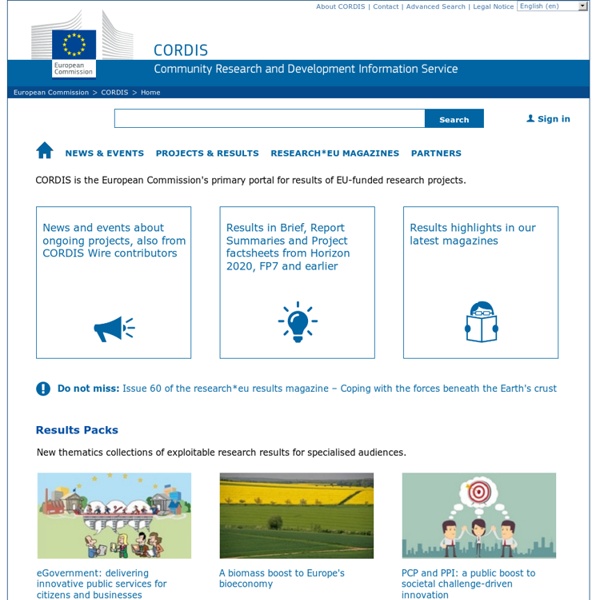



http://cordis.europa.eu/home_en.html
European Commission: CORDIS: FP7 : Find a project About CORDIS | Contact | Search | Legal Notice Community Research and Development Information Service - CORDIS European Commission > CORDIS > Funding Programmes > Find a project Rapports LARA — Libre accès aux rapports scientifiques et techniques— vous permet de consulter librement et gratuitement l'intégralité des rapports scientifiques et techniques qui vous intéressent. LARA ne présente pas de rapport à caractère confidentiel. Ce nouveau site est né de l'engagement du CNRS dans le mouvement de l' Open Access et s'inscrit dans le prolongement du rôle de l' INIST-CNRS en tant que guichet national pour la collecte des rapports scientifiques et techniques français. LARA est un site fédérateur et multidisciplinaire, alimenté par différents laboratoires, instituts, centres de recherche et organismes français. Il a pour objet la valorisation de la littérature grise scientifique et technique et plus précisément des rapports, qu'ils soient techniques, de recherche, d'étude, d'activité, institutionnels…
Lifelong Learning Programme 2007-2013 Comenius - Action for school The Comenius programme focuses on the first phase of education, from pre-school and primary to secondary schools. It is relevant for all members of the education community: pupils, teachers, local authorities, parents associations, non-government organisations, teacher training institutes, universities and all other educational staff. Learn more about Comenius Erasmus - Higher education Erasmus is the EU's flagship education and training programme in the field of higher education. SETIS: providing targeted support to the SET-Plan — SETIS SET-Plan and SETIS Overview The European Strategic Energy Technology (SET)-Plan aims to transform energy production and use in the EU with the goal of achieving EU worldwide leadership in the production of energy technological solutions capable of delivering EU 2020 and 2050 targets. The move towards a low-carbon Europe requires innovative research, effective strategic planning and an emphasis on timely and appropriate action. SET-Plan Three SET-Plan Communications in 2006, 2007 and 2009, introduced the SET-Plan concept, launched the plan (including the commitment to create SETIS) and determined the financial requirements to implement the SET-Plan based on a number of technology roadmaps for the first set of priority technologies. A fourth Communication, in 2013, is expected to reinforce the modalities of the SET-Plan implementation, as the overarching umbrella for energy research and innovation for the Horizon 2020 initiative.
INPI Direccte Country Trends During 2006-2012, the PRO INNO Europe® initiative has been the focal point for innovation policy analysis and policy cooperation in Europe, aimed at learning from the best and contributing to the development of new and better innovation policies in Europe. The ultimate objective was to help European enterprises to innovate better and faster and to optimise and leverage complementarities between the various innovation support measures in Europe, be it at regional, national or European level. To achieve this, PRO INNO Europe® has given a prominent role to national and regional innovation policy and innovation support actors. The initiative comprises 5 building blocks that provide an integrated policy approach to develop new and better innovation policies.
Innovation Union Scoreboard - Industrial innovation - Enterprise and Industry The EU and all EU Member States have become more innovative in recent years. As a result, the EU has closed half of the innovation gap towards the US. However, the differences in the innovation performance within the EU are still very high and diminish only slowly. The innovation gap widens at regional level where the innovation performance has worsened in almost one fifth of EU regions according to the Regional Innovation Scoreboard 2014, which complement the IUS 2014. Ostrefcom A recent hypothesis (the theory of 'natural pedagogy') proposes that an important function of human ostensive-referential communication is to allow the transmission of generic (semantic) knowledge to others. The primary potential beneficiaries of such a communication system are children, who are always novices with respect to the culture they are born into. This proposal aims to explore whether and how human infants are prepared to learn from adults through communication, what cognitive and neural systems support such learning process, and how this social learning process changes infants' perception, interpretation and representation of the world. Beyond traditional behavioural methods, we plan to use eye-tracking, electrophysiological (EEG, ERP) and optical imaging (NIRS) techniques to get insights about the online processes of perception, attention and memory during, as well as the understanding of the social and physical world through, non-verbal communication.